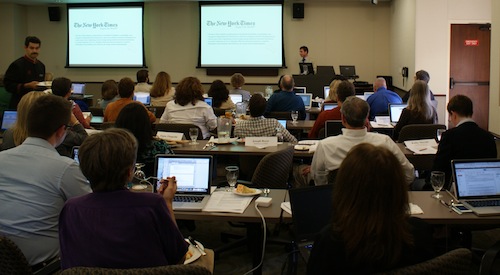Blog:
Community Journalism Executive Training: Define your exit to build a legacy
A huge experiment
CJET brought more than thirty community and investigative publishers together for intensive, hands-on business training. Check out presentations and resources that emerged, download useful know-how.

It felt odd to consider “exit strategy” at the recent Community Journalism Executive Training program, which brought nearly three dozen news organizations to Los Angeles for two days of intense, hands-on work developing specific business strategies and action plans.
After all, the vast majority of organizations attending only opened their doors a few years ago.
But the training, funded by the Knight Foundation, The Patterson Foundation and the McCormick Foundation, hosted by the Knight Digital Media Center and organized by the Investigative News Network, aimed to equip people running startup community and investigative media outlets with the skills and attitude to pull their business-owner hats firmly down on their heads – and wear them all the time.
And that means thinking about exit strategy.
From the start, CJET publishers seemed an eager bunch. A few minutes before the first presentation of the first full day, all were in their seats, facing forward.
The opening question focused on the future – looking further than some were perhaps ready to go.
“What, really, is your exit strategy?” asked Rusty Coats of Coats2Coats, who created the CJET curriculum. “If you have no exit strategy, you have no ability to define success. If you don’t have your eye on where this is going, you don’t know where you are.”
Many publishers figured “exit strategy” meant calling it quits. I later asked people if they had thought about their exit strategy before beginning the business training.
“Besides turning off the site?” replied Jesus Sanchez, who covers several Los Angeles neighborhoods on his site, The Eastsider LA.
“Yeah, we give up,” said Trevor Aaronson, co-director of the Florida Center for Investigative Reporting.
“More of a disaster strategy. The cliff,” said Brent Gardner Smith of Aspen Journalism.
“No,” said 100 Reporters founder Diana Jean Schemo. “To me it means sort of like a DNR, do not resuscitate strategy. I came here seeking a survival strategy.”

Publishers confer at CJET training in Los Angeles. Photo Credit: Jessica Plautz, INN.
Survive, sustain, sell?
For some CJET participants, focusing on exit strategy felt just plain wrong.
“I disagree profoundly that the notion of exit strategy is important,” said Lance Knobel, one of three founders of the independent California news site Berkeleyside.
Knobel brings a background in economics, strategy and management, as well as journalism, to the local news organization. He said thinking exit strategy may be fine for venture capitalists, but he believes it’s “exactly the wrong thing” to consider if you are an entrepreneur seeking to build a lasting institution. “I actually think is a big negative, a really dangerous thing,” Knobel said. “Energies and concentration needs to be on how do we get this to a really durable sustainable state?”
Berkeleyside is successful by many counts. Unique monthly visitors periodically come in higher than the city’s population, events sometimes beat even the organizers’ expectations and other media turn to Berkeleyside staff as experts on local issues. But Knobel said it’s not yet clearly sustainable – to the point the founders could depart and the site would carry on.
Neither is Yellowstone Gate, a site covering the national park and the five communities surrounding it. Founder and editor Ruffin Prevost wants to sell Yellowstone Gate eventually, but he agrees that focusing on his exit strategy now is not important in the short or mid-term.
“It’s important to focus on that somewhat, so you know it has to be something that has real world value,” Prevost said. “If you’re not doing that, it means you’re probably not returning value to your readers or your advertisers.”
But two years after starting the site, thinking about exit strategy doesn’t sit comfortably with him. “If you focus too much on directly monetizing that you lose sight of the whole idea of building some community service into the model.”
Brandy Tuzon Boyd, who started The Natomas Buzz to cover her community in Sacramento said spending time developing an exit strategy is not a priority. “My priority is taking my website from a passion project to a viable business,” she said. “That’s really the long-term goal for me at this point.”
Change “exit” to “legacy”
CJET curriculum creator (and small business owner) Rusty Coats said it is never premature to plan further than your current focus. He said this business norm may feel jarring to journalists, but thinking as far out as the end can help get you where you want to go.
“I don’t know a single startup business outside the indie news space that doesn’t articulate its exit strategy up front,” Coats said. “That sets the path for growth and helps set benchmarks for success.”
He said publishers can use a different word if they want. “Substitute the words “exit strategy” with “legacy” and you get to the same place,” Coats said. “It doesn’t mean being bought out as much as it means evolving.”
CJET participants do know where they want their organizations to go. Suzanne McBride wants AustinTalks.org, based at Columbia College Chicago and covering a nearby neighborhood, to become a model for colleges creating news sites in underserved communities. Lance Knobel wants Berkeleyside to become an “enduring institution.” Teresa Wippel would be thrilled to leave MyEdmondNews in the hands of her writer son. Mark Thomas wants to take CityLimits as far down the sustainability path as he can before the next director of the organization comes in. How far is far enough? “Where you can see two years ahead, and if they do the same things you’d been doing they’d be OK,” Thomas said.

Community publishers in CJET training. Photo Credit: Jessica Plautz, INN.
Exit as opportunity
Jason Alcorn was one of the few participants in CJET whose job focuses on financials more than editorial. He is director of development and community engagement for Investigate West, a nonprofit that partners with other news organizations to sell or distribute its stories. Alcorn said internal conversations about the organization’s future are always put in the context of market assessment. “How do we fit in?” he asked. “We’re complementary to larger investigative news nonprofits, like CIR or ProPublica. So in the same breath we see a business opportunity there, we see an exit strategy, potentially.”
Alcorn said this is contingency thinking – Investigate West’s intent is to succeed as a stand-alone news outlet. But he acknowledges some things are out of the organization’s control, and broad thinking embraces that.
Ned Berke, running the Brooklyn neighborhood site Sheepshead Bites, said thinking exit strategy led him to imagine a few different futures. “One is sell the business, one is make sure it can survive without me, or third, turn it into something larger.”
And Amy Senk, founder (and chief everything) of Corona del Mar Today said considering possible exit strategies gave her ideas for ways out beyond just shutting down.
“I was thinking I would probably just stop doing it, and I don’t know, maybe find a job,” she said on the last day of the CJET training. “Now I’m thinking maybe I’d merge with another paper, or another site, or maybe I would have staff writers who I could direct and I could do more of a publisher role.”
A personal exit strategy
No matter the future of their organizations, many CJET publishers don’t want to spend the rest of their lives as deeply involved as they are now.
“What I think is important in exit strategy is succession,” said Brian Wheeler, executive director of Charlottesville Tomorrow. “I’m assuming the organization will keep going, but I need a plan to make sure someone else can come in and take it over some day.”
Anne Galloway of VTDigger.org agrees. Although she told me on the last day of CJET she “still” hadn’t developed an exit strategy, she thinks about it in terms of the next generation. “Building a large enough staff and infrastructure that I could step away from the role of executive director,” she said. “I’m really sort of training people up, and trying to raise enough money, and build our brand enough to get there.”
Engaged in a huge experiment
During the CJET session when Coats asked publishers about their exit strategies, one participant asked a particularly potent question.
“The assumption is,” she said, “that if we do these things you’re telling us to do, the charitable world and the world of commerce will embrace us.” But it felt to her – and many in the room – that this is an untrod path – that community and investigative publishers are actually “engaged in a huge experiment.”
Coats could only agree. And again, saw opportunity. He told everyone in the room that how they build their businesses will lay the foundation for the future of local publishing – investigative, community, regional, non- or for-profit. “This work,” he said, “begins to inform the model…of what is possible” in building new journalism businesses in a sustainable way.











Weigh In: Remember to refresh often to see latest comments!
4 comments so far.
-
 Lance Knobel says:
Lance Knobel says:
November 13, 2012 at 10:27 am
-
 Rusty Coats says:
Rusty Coats says:
November 13, 2012 at 11:09 am
-
 Emily Harris says:
Emily Harris says:
November 13, 2012 at 3:03 pm
-
 Lance Knobel says:
Lance Knobel says:
November 13, 2012 at 3:39 pm
| ParticipantsThanks for the useful account of the discussion.
I think it’s important to note, however, that in my view talking about “exit strategy” or “legacy” is more than semantic. They are very different things. You quote Rusty as saying he doesn’t know of any startup outside indie news that doesn’t determine its exit strategy up front. I don’t think he’s spent all that much time around startups.
There are, certainly, plenty of startups that obsess about exit strategy. They’re the ones that leap into a bubble with a clear goal, whether it’s to do a quick IPO or get acquired by Google/Facebook/Cisco. It’s the startup equivalent of the people who flipped houses during the real estate bubble.
My point, when we spoke at CJET, is that the businesses most of us really admire were created with absolutely no thoughts about exit strategy. Do you think Adolph Ochs thought about exit strategy when he started The New York Times? What about the Google guys? Zuck? Jack and Biz with Twitter? I could go on. It’s my conviction that focusing on exit strategy is incompatible with creating an enduring business.
Thanks Emily. A great deep-dive on the subject.
As I said in the sessions and in other posts, I use the exit strategy exercise to help snap people out of day-to-day thinking and think long-term. I disagree with Lance that startups (yes, I’ve spent a lot of time with a lot of startups, including nonprofits, service, technology and others, but haven’t had the good fortune to rub elbows with Zuck, Jack or Biz) that think about exit strategies are house-flippers. Most have investors who want to know their money is well spent. One client said his exit strategy “exists so that I don’t settle into complacency.”
I appreciate Lance’s conviction but disagree that exit strategies are incompatible with creating an enduring business, or that “legacy” is (as it pertains here) more than a semantic difference. That said, the exercise only works if it challenges assumptions and creates new ways of thinking about your business, even if you refute them.
Lance, that’s right, you talked about the founders of great technology companies being motivated by a conviction and passion for what they are doing. And I get your point that exit strategy and legacy are, in fact, different things, though they might share space on a Venn diagram. What I still don’t know is what kind of long term – maybe endgame? – planning, or perhaps just thinking, you think is smart for a startup to do. Could Ochs, Zuck, etc. all have had “world domination” as a vague sense of where they were going? Would that be helpful? Motivating? Grown from passion? What IS worth spending time imagining as a place to go when you’re starting out?
Good questions, Emily. If your comment box allowed for replies with unlimited length (I had to chop down my earlier comment), I might be able to get part way to an answer.
What I think great founders do share is a passionate belief in what they do. That’s what drives them to do something that, in terms of probability of success, doesn’t make any sense.
My jihad against exit strategies does not mean that I’m against thinking about the future. I think that’s essential. But, to my mind, that future should precisely not be about “exit”. That’s for the house flippers (sorry, Rusty). The forward thinking should be about developing a clear vision for where you want to go — what some people in the innovation consulting business (which I did for a few years) call a “desired future state”. If the desired future is a pot of gold (or a secure retirement, or an assured salary, etc), then you shouldn’t be in a startup.
What’s important to understand is that the path to this desired future will be highly non-linear. It doesn’t lend itself very well to elaborate planning. It’s not an engineering problem. It’s a design problem.